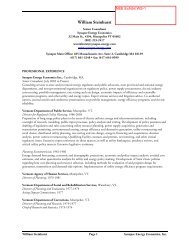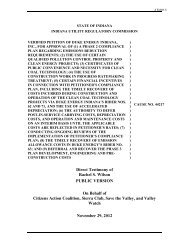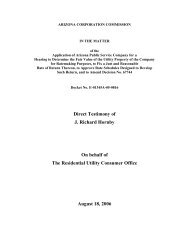Best Practices in Energy Efficiency Program Screening - Synapse ...
Best Practices in Energy Efficiency Program Screening - Synapse ...
Best Practices in Energy Efficiency Program Screening - Synapse ...
You also want an ePaper? Increase the reach of your titles
YUMPU automatically turns print PDFs into web optimized ePapers that Google loves.
The Societal Cost test is the most comprehensive test, and is most appropriate for those<br />
states that wish to give consideration to the societal benefits of energy efficiency<br />
programs, particularly the environmental and health benefits. The disadvantages of this<br />
test are that some stakeholders may view the scope as outside the <strong>in</strong>terests and<br />
jurisdiction of regulatory commissions; some of the societal impacts are uncerta<strong>in</strong> and<br />
difficult to forecast; and this test might lead to undesirable cost impacts on utility<br />
customers.<br />
The TRC test is the next most comprehensive test, and is the most widely used test.<br />
Regulators and legislators are apparently drawn to this test because it <strong>in</strong>cludes the total<br />
<strong>in</strong>cremental impacts of efficiency measures. However, the TRC test creates a dilemma<br />
for policymakers. In order to be <strong>in</strong>ternally consistent the test must <strong>in</strong>clude other program<br />
impacts on the program participants, but regulators are often wary of do<strong>in</strong>g so because<br />
some of the costs are uncerta<strong>in</strong> and difficult to quantify. In addition, some stakeholders<br />
are concerned that <strong>in</strong>clud<strong>in</strong>g OPIs <strong>in</strong> the assessment of energy efficiency could lead to<br />
utility customers pay<strong>in</strong>g higher costs for efficiency programs <strong>in</strong> order to pay for other<br />
program benefits that are not <strong>in</strong> their <strong>in</strong>terest and should not be paid for through utility<br />
rates.<br />
The PAC test is most appropriate for those states that want to limit the energy efficiency<br />
cost-effectiveness analysis to the impacts on revenue requirements. There are many<br />
advantages to this test: it is consistent with the way that supply-side <strong>in</strong>vestments are<br />
evaluated; it <strong>in</strong>cludes costs that are relatively easy to identify and quantify; and it<br />
<strong>in</strong>cludes the energy costs and energy benefits that are most important to utility<br />
regulators. Probably the most important benefit of the PAC test is that it provides<br />
legislators, regulators, consumer advocates and others with confidence that the energy<br />
efficiency programs will result <strong>in</strong> lower costs to utility customers. This is an extremely<br />
important consideration, particularly for those states that seek to implement all costeffectiveness<br />
energy efficiency resources.<br />
However, rely<strong>in</strong>g on the PAC test has one significant disadvantage <strong>in</strong> that the costs and<br />
benefits to energy efficiency program participants are not taken <strong>in</strong>to consideration. There<br />
are two implications of this. First, by not <strong>in</strong>clud<strong>in</strong>g the participant’s cost the PAC test<br />
does not <strong>in</strong>clude the full <strong>in</strong>cremental cost of efficiency measures, which may be<br />
important to policymakers. Second, the PAC test does not <strong>in</strong>clude the other program<br />
benefits of efficiency measure, some of which are clearly important to policy makers.<br />
The other program benefits that are typically most important to regulators are (a) those<br />
benefits that perta<strong>in</strong> to low-<strong>in</strong>come customers, because of the significant public policy<br />
implications of this sector; and (b) the other fuel sav<strong>in</strong>gs, because these sav<strong>in</strong>gs are<br />
important to promote comprehensive, whole-house, one-stop-shopp<strong>in</strong>g residential<br />
retrofit programs as well as new construction programs where customers tend to use<br />
multiple fuels. In Section 4.1 we provide an illustration of how these two types of benefits<br />
can have a significant impact on program cost-effectiveness.<br />
Once the scope is established, it is important to ensure that the test be<strong>in</strong>g applied<br />
<strong>in</strong>cludes all the appropriate costs and benefits <strong>in</strong> a way that is <strong>in</strong>ternally consistent. For<br />
example, when apply<strong>in</strong>g the PAC test it is important to <strong>in</strong>clude all the costs and all the<br />
benefits that are expected to affect utility revenue requirements. Similarly, when apply<strong>in</strong>g<br />
the TRC test it is important to <strong>in</strong>clude all the participant benefits as well as the participant<br />
costs <strong>in</strong> order to ma<strong>in</strong>ta<strong>in</strong> <strong>in</strong>ternal consistency. Otherwise, the test results will be skewed<br />
and mislead<strong>in</strong>g. These issues are discussed <strong>in</strong> more detail <strong>in</strong> Section 4.1. In addition, it<br />
is important to ensure that there is no double-count<strong>in</strong>g of costs or benefits <strong>in</strong> the test<br />
| 18 <strong>Best</strong> <strong>Practices</strong> <strong>in</strong> <strong>Energy</strong> <strong>Efficiency</strong> <strong>Program</strong> Screen<strong>in</strong>g | www.nhpci.org







